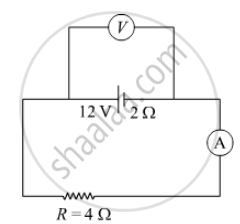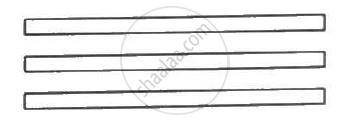Advertisements
Advertisements
प्रश्न
The potential difference applied across a given resistor is altered so that the heat produced per second increases by a factor of 9. By what factor does the applied potential difference change?
उत्तर
We know, the heat (H) produced across a resistor in time t due to flow of current (I) through it is
`H =V^2/Rt`
where, V is the potential difference applied across resistor R which gives current I.
Therefore, heat produced per second is
`H/t =V^2/R`
`⇒V^2 prop H or V prop sqrtH ` ...(i)
Now when the potential difference is altered from V to say V', then the heat produced per second increases by factor of 9
`⇒V' prop sqrt(9H)`
`or V' prop 3sqrtH` ...(ii)
Dividing (i) by (ii), we get
`(V')/V = (3sqrtH)/sqrtH`
`⇒V' = 3 V`
Hence, the potential difference changes by a factor of 3.
संबंधित प्रश्न
In the figure shown, an ammeter A and a resistor of 4 Ω are connected to the terminals of the source. The emf of the source is 12 V having an internal resistance of 2 Ω. Calculate the voltmeter and ammeter readings.

Explain the principle of a device that can build up high voltages of the order of a few million volts.
The capacitance between the adjacent plates shown in the figure is 50 nF. A charge of 1.0µC is placed on the middle plate. If 1.0 µC is placed on the upper plate instead of the middle, what will be the potential difference between (a) the upper and the middle plates and (b) the middle and the lower plates?

Two capacitors of capacitance 20⋅0 pF and 50⋅0 pF are connected in series with a 6⋅00 V battery. Find (a) the potential difference across each capacitor and (b) the energy stored in each capacitor.
Answer the following question:
Find the expression for the resistivity of a material.
If a positive charge moves in the direction of the electric field ______.
A and B are two points in an electric field. If the work done in carrying 4.0C of electric charge from A to B is 16.0 J, the potential difference between A and B is:
An α-particle and a proton are accelerate at same potential difference from rest. What will be the ratio of their final velocity?
A bullet of mass of 2 g is having a charge of 2 µc. Through what potential difference must it be accelerated, starting from rest, to acquire a speed of 10 m/s.
If potential difference between the two ends of a metallic wire is doubled, drift speed of free electrons in the wire ______.
